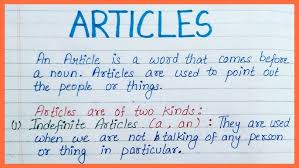The Power of Articles in Communication and Information Sharing
Articles play a crucial role in conveying information, educating readers, and sparking discussions on a wide range of topics. Whether in print or digital form, articles serve as a primary medium for sharing knowledge and ideas with a broad audience.
Educational Value
Articles provide valuable insights into various subjects, from science and technology to arts and culture. They can offer in-depth analysis, research findings, and expert opinions that help readers expand their knowledge and understanding of the world around them.
Informative Content
Articles are a reliable source of information on current events, trends, and developments in different industries. By presenting facts, statistics, and case studies, articles help readers stay informed and make well-informed decisions in their personal or professional lives.
Engagement and Discussion
Well-crafted articles have the power to engage readers by presenting compelling narratives, thought-provoking arguments, or entertaining stories. They can inspire discussion, debate, and reflection among individuals who share common interests or diverse perspectives.
Accessibility and Reach
With the rise of digital publishing platforms and social media channels, articles have become more accessible than ever before. Readers can easily access articles online through websites, blogs, e-magazines, or social networking sites, reaching a global audience within seconds.
Credibility and Authority
Articles published by reputable sources such as academic journals, news outlets, or industry publications carry credibility and authority. Readers often rely on these sources to obtain accurate information from experts in their respective fields.
Conclusion
In conclusion, articles play a vital role in communication and information sharing by providing educational value, informative content, engagement opportunities, accessibility across digital platforms, as well as credibility from trusted sources. As we continue to embrace the power of written content in the digital age, articles will remain a cornerstone of effective communication for years to come.
Understanding Articles: Examples, Definitions for Kids, Categories, and Key Rules
- What are examples of articles?
- What are articles for kids?
- What counts as articles?
- What are the 7 rules of articles?
What are examples of articles?
Articles come in various forms and serve different purposes across print and digital media. Some common examples of articles include news articles reporting on current events, feature articles exploring in-depth topics or profiles, opinion pieces expressing personal viewpoints, how-to articles providing step-by-step instructions, and academic articles presenting research findings in scholarly journals. Additionally, lifestyle articles cover topics such as health, fashion, travel, and entertainment, while listicles offer information in a concise list format. These diverse types of articles cater to a wide range of interests and audiences, showcasing the versatility and impact of written content in communication and information sharing.
What are articles for kids?
Articles for kids are written pieces of content specifically tailored to engage and educate young readers. These articles are designed to be age-appropriate, informative, and entertaining, covering a wide range of topics that cater to children’s interests and curiosity. Whether exploring science, history, nature, or storytelling, articles for kids aim to spark imagination, foster learning, and encourage a love for reading from an early age. By presenting information in a clear and engaging manner, these articles help children develop their literacy skills, critical thinking abilities, and broaden their understanding of the world around them in a fun and accessible way.
What counts as articles?
Articles encompass a wide range of written pieces that aim to inform, educate, entertain, or persuade readers on various subjects. They can take the form of news reports, feature stories, opinion pieces, research papers, blog posts, and more. What counts as articles often depends on the context in which they are presented and the purpose they serve. Whether published in traditional print media or digital platforms, articles typically follow a structured format with a clear introduction, body containing relevant information or arguments, and a conclusion that summarizes key points. The diversity of article types allows for a rich tapestry of content that caters to different interests and audiences.
What are the 7 rules of articles?
Understanding the seven rules of articles is essential for mastering English grammar. Articles, including “a,” “an,” and “the,” play a crucial role in specifying and indicating the noun they precede. The rules include using “a” before consonant sounds and “an” before vowel sounds, using “the” to refer to specific or known nouns, omitting articles with non-countable nouns, and using articles to introduce new information or make generalizations. Adhering to these rules helps ensure clarity and precision in written and spoken communication.

